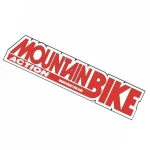2008 RockShox Boxxer WC Fork: Test and Setup Tips

Crown jewel: The top crown of the Boxxer is capable of using a direct-mount or steerer clamp stem. We’re bigger fans of the direct mount stem, and have a couple of new designs from Chromag and Sunline we’re anxious to throw on this Boxxer.
DIALING IN THE BOXXER
RockShox has three versions of the Boxxer fork: the race-engineered World Cup, the coil-sprung Team, and the budget-minded Race. Like the 2007 version, the ’08 Boxxer World Cup has eight inches of travel and uses a Solo air spring. Spring adjustments are made via a single Schrader valve atop the left fork leg. The World Cup Boxxer features Motion Control damping with a BlackBox speed stack and the Maxle 20-millimeter thru-axle. External adjustments include rebound, and low- and high-speed compression. The standard color is Athena white. The black lowers are only found on production bikes.
HOW TO SET UP THE BOXXER FORK

Podium performer: The RockShox Boxxer has dominated World Cup racing, and won back-to-back world championships by Sam Hill and Sabrina Jonnier. The Boxxer World Cup is proven to perform on the most demanding of courses.
RIDING THE BOXXER WORLD CUP
From the start, the World Cup felt like no other downhill fork we’ve ridden (other than the 2007 World Cup). It’s quite light for an eight-inch fork at 6.3 pounds, and from our first practice run to our final race run, it performed with predictable handling and confidence-building damping performance. Contrary to popular thought, the small-bump sensitivity of the air spring was superb. Meanwhile, the Motion control tuning is very consistent and easy to dial in. If you turn the blue knob (high-speed compression) all the way to the right, you’ll be in for a harsh ride. This is a premium, race-designed downhill fork made to tackle whatever the toughest World Cup downhill courses can throw at it, so we left the Flood Gate relatively open and turned the blue Motion Control knob a couple of clicks to the right for increased compression damping on black-diamond-level terrain. This adjustment helped at speed on the faces of jumps and launching big drops onto choppy landings. We mounted the World Cup to our Intense Socom downhill racer. Immediately, the bike’s handling became more agile, and we never feared launching a high-speed double or charging multiple technical sections of trail. The Boxxer always took the brunt of the impacts and reliably returned to position ready for more. With many downhill forks, there are some flaws in performance that once noticed will change how you ride them. For example, some dual-crown sliders have a ‘dead’ feel which isn’t ideal for taking to the air on jumps. Some bottom too easily or don’t reliably return to full-travel when repeatedly being battered on gnarly trails. The Boxxer World Cup impressively handled all aspects of technical downhill riding. Its agile feel made it fun to launch high-speed jumps and lean into corners, while the superb damping performance gave us assurance in rocky and very technical terrain.
POUND-FOR-POUND CHAMPION
The air-sprung Boxxer World Cup has been in development since 1999 and debuted in 2007. Some of the most talented riders in the world have given their feedback, making the World Cup what it is today. With riders like Sam Hill, Steve Peat (who’s been riding RockShox for ten years), Nathan Rennie, Eric Carter, Sabrina Jonnier, Kirt Voreis, Bryn Atkinson and Mick Hannah, the Boxxer has evolved into a premium downhill racing fork. We have yet to ride another eight-inch slider with such a simple setup procedure, easy tuning, and consistent performance. Whether you’re a 150-pound or 250-pound rider, the Boxxer World Cup’s air-spring and Motion Control damping can give you a custom-tuned ride to match your riding style and ability—without searching for steel or titanium springs. The sweet science of the BlackBox program has developed a top-performing downhill fork, and the technology has trickled down to the consumer. The RockShox Boxxer World Cup tops the list of our race-ready premium downhill forks and is ideal for serious racers. RockShox, (312) 664-8800.

Fine tuned: The incremental clicks of the Motion Control knob provided plenty of high-speed compression tuning options for gnarly terrain. The Flood Gate (gold knob) sets the level of how much force, or how soon the ‘blow-off’ circuit is engaged and flows into the high-speed compression circuit.




